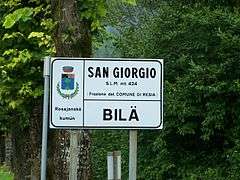Resian dialect
The Resian dialect (self-designation Rozajanski langač, or lengač, Slovene: rezijansko narečje, rezijanščina) is a distinct dialect of Slovene spoken in the Resia Valley, Province of Udine, Italy, close to the border with Slovenia.[2][3][4] Because of its remote location outside Slovenia, the dialect has phonetic properties different from standard Slovene, and from most other Slovene dialects. Many, arguably the majority, of its speakers consider it a separate language.
| Resian | |
|---|---|
| Rozajanski langač/lengač | |
| Native to | Italy |
| Region | Resia valley |
Indo-European
| |
| Language codes | |
| ISO 639-3 | – |
| Glottolog | resi1246[1] |
| South Slavic languages and dialects | ||||||
|---|---|---|---|---|---|---|
|
Western South Slavic
|
||||||
|
Eastern South Slavic
|
||||||
|
Transitional dialects
|
||||||
|
Alphabets
|
||||||
Characteristics
Although not a regulated dialect (scholars consider it a dialect of Slovene rather than a different language),[2][3][4] and without any official status in Italy, Resian is written with a Latin script different from that used for standard Slovene. The alphabet contains the letter ⟨w⟩, a letter that few Slavic languages use (only Polish, Kashubian and Upper and Lower Sorbian). This grapheme—according to the Italian linguist Bartoli—is characteristic of the Ladin language of the eastern Alps and indicates the autochthonous Neolatin population's strong influence on Resian.
Historical development and linguistic features

Most contemporary scholars consider Resian a transitional dialect between the Carinthian and Littoral dialects of Slovene.[5][6] Linguists identify three historical layers in the development of Resian. Initially, Resian was a part of the Carinthian Gail Valley dialect (spoken south of Villach, Austria, but also in the Italian municipalities of Malborghetto Valbruna and Tarvisio, and in the towns of Rateče and Kranjska Gora in Slovenia). In the 14th century, with the German and Friulian colonization of the Canale and Raccolana valleys, the connection of Resian with Carinthian dialects was interrupted. Starting from the 15th century, Resian acquired specific features of Venetian Slovenian dialects (especially the vocabulary). The third layer is represented by specific innovations and developments, which are unique to Resian and cannot be found in any other Slovene dialect.
In addition, Resian has maintained a number of archaisms (including the aorist) that have disappeared both in standard Slovene and most other Slovene dialects. Atypical for a Slavic language, Resian has a definite article: masculine te, feminine ta (the only standard Slavic languages to contain definite articles are Bulgarian and Macedonian).
This historical development helps to understand the specifics of Resian in regards to other Slovene dialects. Regarding the vocabulary, Resian is very similar to other western Slovene dialects, both from the Littoral and Carinthian dialect group: especially the Natisone Valley dialect, Torre Valley dialect, Gail Valley dialect, Brda dialect and upper Soča dialect. It however distinguishes sharply from these neighboring dialects in its phonetics. Resian sounds very different from other Slovene dialects, especially regarding the vowel system; nevertheless, some of its features are common to the Carinthian dialect group.
Mutual intelligibility with Slovene
Written Resian can mostly be understood by Slovenes, but spoken Resian is much harder to understand, especially for those from central and eastern Slovenia. Resian forms a part of the South Slavic dialect continuum, and shares numerous features with the dialects spoken in the Slovenian Littoral and Venetian Slovenia, and communication between these communities is intelligible. However, Resian and standard Slovene are mutually unintelligible due to archaisms lost in modern Slovene, and due to significant Italian and Friulian influences on Resian vocabulary.
Scholars
Notable linguists who have studied the dialect include Jan Niecisław Baudouin de Courtenay, Eric Hamp, Milko Matičetov, and Roberto Dapit.
See also
- Friuli
- Venetian Slovenia
- Slovene Lands
References
- Hammarström, Harald; Forkel, Robert; Haspelmath, Martin, eds. (2017). "Resia". Glottolog 3.0. Jena, Germany: Max Planck Institute for the Science of Human History.
- Steenwijk, Han (1992). The Slovene Dialect of Resia: San Giorgio. Amsterdam: Rodopi. p. 1.
- Pronk, Tijmen (2009). The Slovene Dialect of Egg and Potschach in the Gailtal, Austria. Amsterdam: Rodopi. p. 2.
- Stankiewicz, Edward (1986). The Slavic Languages: Unity in Diversity. Berlin: Mouton de Gruyter. p. 93.
- Rigler, Jakob (1986). Razprave o slovenskem jeziku. Ljubljana: Slovenska Matica v Ljubljani. p. 100.
- Natale Zuanella (1978). "Informacija o jezikovnem položaju v Beneški Sloveniji – Informazione sulla realtà linguistica della Slavia Veneta". Atti: conferenza sui Gruppi Etnico Linguistici della Provincia di Udine. Cividale del Friuli: SLORI. p. 273.
| Wikimedia Commons has media related to Resian dialect. |
External links
- Resianic homepage, containing texts in Italian, German, Slovenian, and English, as well as a Resian-Slovenian dictionary